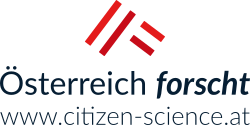Explore Citizen Science Projects
Welcome at Österreich forscht!
Here you can find everything about Citizen Science in Austria. In the future, it should be just as normal to work in a citizen science project as to be a member of an association, e. g. the voluntary fire brigade or a music ensemble. We want people to see science no longer as an elite programme, but as a process that affects all our lives, a process which is an important part of society and is worth understanding. However, the fun and enjoyment of research should not be neglected. We do not understand citizen science as an infotainment concept, but as a collaborative process through which new insights can be gained.
City Nature Challenges in Austria
- plants
- fungi
- animals
Every observation counts! The City Nature Challenge (short: CNC) is an annual nature competition between regions that takes place in spring (usually at the end of April, beginning of May) and is held simultaneously in various cities and regions worldwide. On four consecutive days, people around the world document the…
Ural owl
- animals
Ural owl resettlement The resettlement of the Ural owl is led by a team of researchers headed by ornithologist Richard Zink at the Austrian Ornithological Centre at "Vetmeduni" Vienna. The goal is the "Come Back" of the big owl into the forests of Austria. A new occurrence in the alps…
Octopus Den Initiative
- animals
- water
How do octopuses use the artificial octopus dens near the Croatian island of Krk, and what can be studied with them? Film or photograph them during your next dive or snorkeling trip to contribute to octopus research! What are the aims of the project? The project investigates whether and to…
Waterbird Census
- animals
Citizen Science with a long tradition The first water bird counts in Austria took place as early as the 1950s. In the following years, the number of counts was gradually increased, and from 1970 onwards Austria-wide surveys have been carried out. This makes the waterbird census one of the longest…
Breeding bird monitoring
- animals
Annual counts This advanced citizen science project requires knowledge of the common native breeding bird species and participation over several years. Twice a year, the participants count all birds seen and heard at fixed points. The total of all counts is then used to calculate population trends. The available data…
BIOM-Garten
- animals
Monitoring of Amphibians and Reptiles in Austrian Gardens The BIOM-Garten project invites people of all ages to look out for amphibians and reptiles in their gardens and report their observations. This will help to fill gaps in existing monitoring and implement better conservation measures for these endangered animals. What are…
SoilBlitz
- food
- land use
- plants
A snapshot of soil health With the SoilBlitz, Citizen Scientists independently carry out tests to determine local soil health, collect important data and become aware of the importance of healthy soils. What are the aims of the project? In a so-called ‘SoilBlitz’, five uncomplicated and fast tests are carried out…
Bug us with your ticks!
- health
- animals
For our national tick monitoring programme, we invite you to provide us with ticks. Your samples will help us analyse which tick species appear when and where in Austria. Moreover, ticks will also be investigated for the presence of pathogens. What are the aims of the project? The goal of…
Vienna Kestrel
- animals
The kestrel is the most common raptor in the city of Vienna. Since 2010, the "Vienna Kestrel Project" has been investigating how these falcons have adapted to city life. A key component of our research is knowledge about nest locations which allow us to access broods for further investigation. The…
Fire Database
- plants
- weather
- economy
- land use
- catastrophs
In the Institute of Silviculture at the BOKU University, the occurrence, spread, causes and characteristics of forest fires in Austria have been analysed as part of various research projects since 2008. The array stretches back over several decades and includes approximately 8,000 fires, more than 7,000 of which were categorised…
Wettermelden.at / Trusted Spotter Network Austria
- wetter
- katastrophen
Many weather phenomena as well as their impacts and damage on the ground are reported in real time or immediately after the event by means of weather reports. Within the framework of the Trusted Spotter Network Austria, all reporters can be trained to become particularly trustworthy observers. All weather and…
Kremser scorpion
- animals
- history
Participatory exploration of the "Kremser scorpion” (Euscorpius tergestinus) with school students "Triestino scorpion" (Euscorpius tergestinus - still listed as E. carpathicus in the Red List of NÖ), which are threatened with extinction in Lower Austria, exists as an archaeozoon in Krems. This population is an isolated north-eastern outpost of the…





